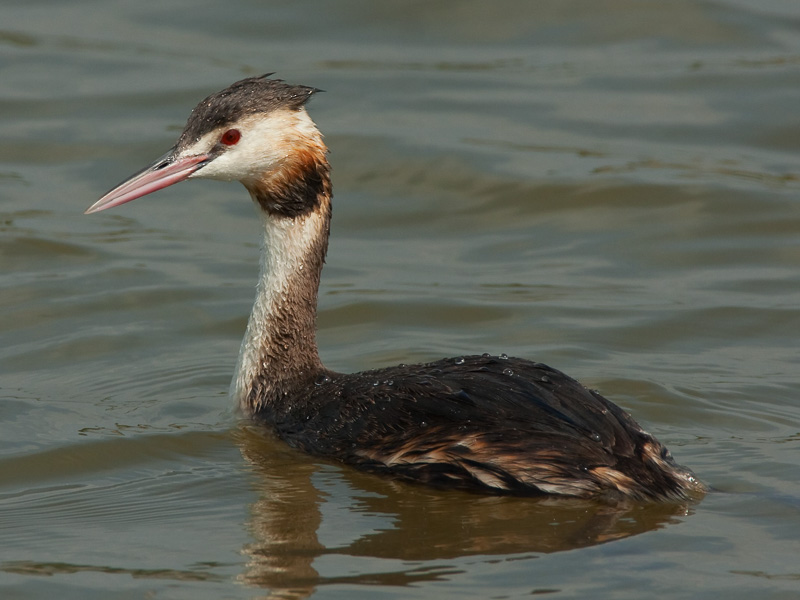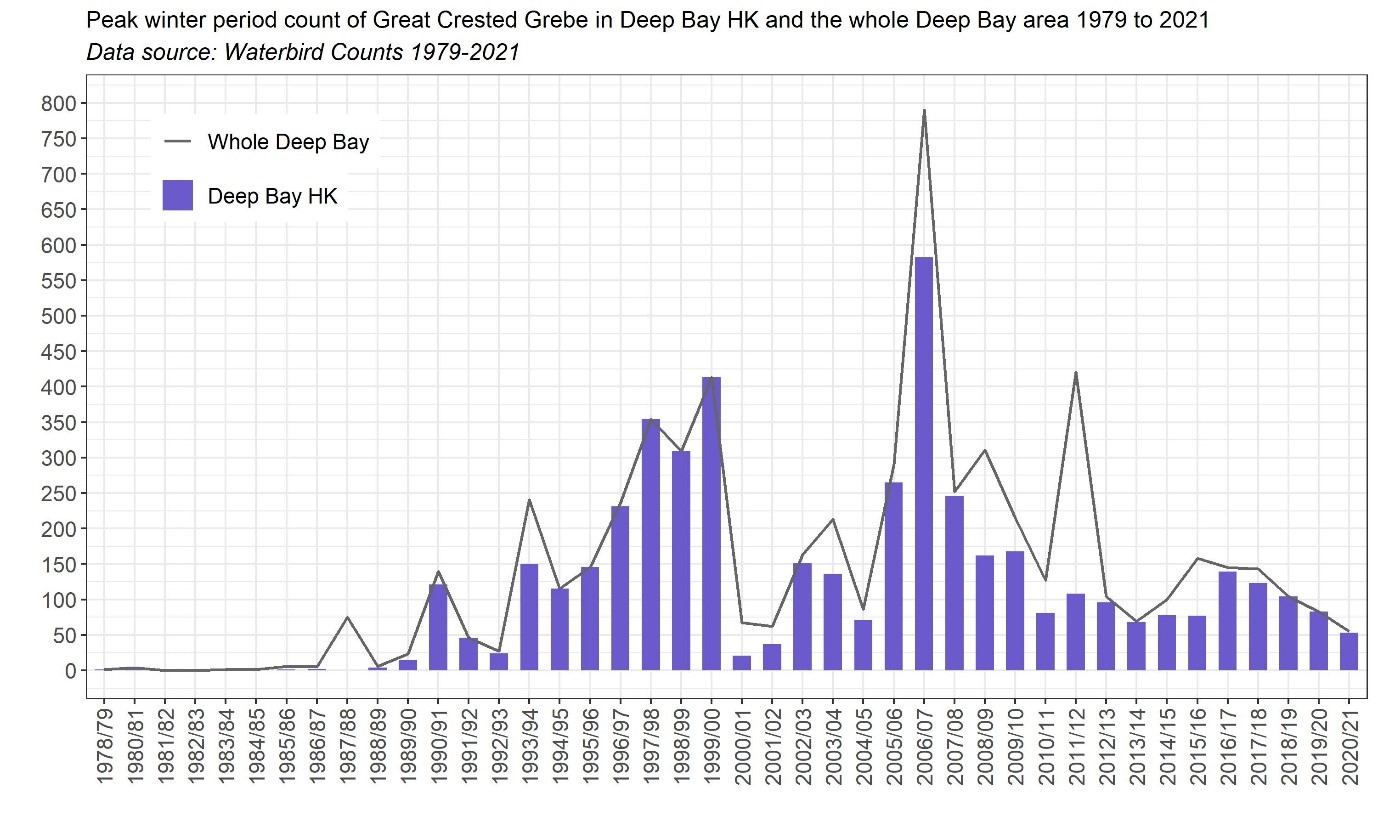Great Crested Grebe Podiceps cristatus 鳳頭鸊鷉
Category I. Common winter visitor to intertidal areas of Deep Bay, though numbers may be in decline.
IDENTIFICATION

Jan. 2009, James Lam.
46-61 cm. Long body carried low in the water with relatively long neck and long slender largely pale bill. Most birds seen in HK are in winter plumage, though breeding plumage feathers can be apparent from as early as late December.
In non-breeding plumage the face to just above the eye and the fore part of the neck are white, while a line from eye to bill and the crown are dark. As winter progresses some birds show the beginnings of breeding plumage in the form of warm brown feathering at junction of head and neck and black crest feathers (as in the photograph).
In flight it appears rather long and slender in shape and has extensive white areas along the leading edge of the inner wing and on the secondaries.
VOCALISATIONS
Rather quiet on the wintering grounds. The distance at which most birds in HK are usually seen probably precludes vocalisations being heard.
DISTRIBUTION & HABITAT PREFERENCE
Most records are from the shallow coastal waters of Deep Bay, with the area from Tsim Bei Tsui to Lau Fau Shan favoured. Only occasionally do birds venture further inland to appear on ponds in Mai Po NR or on commercial fish ponds. Most such records appear to be of single migrants from 1 March to 4 May, although one was present from 10 January to 25 October 2010 (the only record of over-summering). More recent records, however, have mostly occurred in the main winter period from 10 November to 18 February 2019, with one on 3 April 2015 apparently a migrant.
The second regular wintering site in Hong Kong is Starling Inlet, where up to 26 birds have been recorded. The only significant count away from these sites is of 63 birds in the area around the airport at Chek Lap Kok. Surprisingly, the only records from Tolo Harbour are of singles at Shuen Wan on 7 March 2002 and 6 January 2003, and one next to Plover Cove dam on 1 January 2008. One was found dead on the Po Toi shoreline on 2 April 2009, and one was seen in Port Shelter, Sai Kung on 24 December 1934 (Herklots 1967).
OCCURRENCE
A winter visitor to Hong Kong typically present from November to the third week of April, with extreme dates being 1 September 2011 and 12 May 1995. One bird remained the summer at Mai Po in 2010.
Figure 1 indicates that in the early years of waterbird counts the numbers recorded were relatively low, with most counts below 50; the highest count up to winter 1992/93 was 140 (of which 19 were at Fu Tian). From winter 1993/94 numbers rose to reach 413 on 15 January 2000. Subsequently there were five years of relatively low numbers before an increase saw a count of 790 on 17 December 2006, of which 582 were on the HK side of the bay and 208 were at Fu Tian; these are the highest counts recorded. Subsequently the highest count was 420 on 18 December 2011, of which 312 were at Fu Tian, but since that winter counts have been no higher than 158. A count of 515 referred to in HKBR 2016 and HKBR 2017 is in error.
Vaughan and Jones (1913) stated that Great Crested Grebe was a common winter visitor to the Pearl River Delta, Herklots (1953) recorded it mainly in January and February, while Macfarlane and Macdonald (1966) noted it between 1 November and 16 April.
BEHAVIOUR, FORAGING & DIET
An obligate piscivore, it has been photographed consuming Tilapia Oreochromis sp. Forms loose flocks in Deep Bay that move with the tide in Inner Deep Bay.
RANGE & SYSTEMATICS
Breeds from Europe east though western Russia, Central Asia, southern Siberia and Mongolia to northeast China; in winter it occurs on open water offshore or on lakes or reservoirs in north and south Africa, around the Black and Caspian Seas, the northern part of the Indian subcontinent to south China and southern Japan (Llimona et al. 2020). In China it breeds in north and northeast provinces and in scattered areas of western China, and winters in areas south from the Yangtze floodplain to the coast, including Taiwan (Liu and Chen 2020).
The nominate form occurs in Eurasia, including HK. Two other subspecies are recognised, one in Africa, the second in Australasia.
CONSERVATION STATUS
IUCN: Least Concern. Population trend unknown.
Based on an estimated east Asia non-breeding population of 25,000-50,000 (Wetlands International 2022), the last winter period in which Deep Bay supported 1% or more of the regional population was 2011/12. Since then, numbers have been too low to reach this threshold.
Figure 1.

Herklots, G. A. C. (1953). Hong Kong Birds. South China Morning Post, Hong Kong.
Herklots, G. A. C. (1967). Hong Kong Birds (2nd ed.). South China Morning Post, Hong Kong.
Liu, Y. and Chen, Y. H. (eds) (2020). The CNG Field Guide to the Birds of China (in Chinese). Hunan Science and Technology Publication House, Changsha.
Llimona, F., J. del Hoyo, D. A. Christie, F. Jutglar, and G. M. Kirwan (2020). Great Crested Grebe (Podiceps cristatus), version 1.0. In Birds of the World (J. del Hoyo, A. Elliott, J. Sargatal, D. A. Christie, and E. de Juana, Editors). Cornell Lab of Ornithology, Ithaca, NY, USA. https://doi.org/10.2173/bow.grcgre1.01
Macfarlane, A. M. and Macdonald, A. D., revised by Caunter, J. R. L. and Macfarlane, A. M. (1966). An Annotated Check-list of the Birds of Hong Kong. Hong Kong Bird Watching Society, Hong Kong.
Vaughan, R. E. and Jones, K. H. (1913). The birds of Hong Kong, Macao and the West River or Si Kiang in South-East China, with special reference to their nidification and seasonal movements. Ibis 1913: 17-76, 163-201, 351-384.

